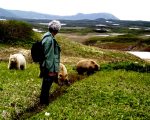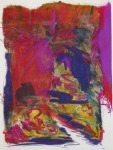
Maureen photographing a bear.

Charlie with the
re-introduction cubs -
Biscuit, Chico and Rosie.

Maureen's artwork
(Click on any Image to see a higher resolution version)
A: COMMUNICATION
- The Vocabulary Of Body Language.
We are experimenting with human body positions to dispel aggressive responses in bears. We are also trying to log an understanding of the bears’ body positions and responses to human sightings. When we meet a wild bear we consciously try to relax our body, sometimes turning our attention away from the bear. We notice the ‘stand up’ is the bear’s first response to what it fears and when it wants to see or smell better. Bears seem to register instantly every nuance of our body’s expressions. We need to understand in great detail what our subtlest body movements mean to a bear.
- Inflection of Sounds/Voice
The human voice is the number one tool for staying out of trouble with bears. It is not so much the words, but the inflection that is listened to. We suspect panic sounds from man are often misunderstood as aggressive ones and elicit angry responses from bears. Therefore we talk in a quiet calm way to bears and notice our voice will dispel their anxiety. Trust can be established with understanding of the use of voice. Within a day our cubs learned “NO” and likewise I, Charlie, have used “NO” to set limits with wild bears.
We are now starting to interpret bear noises and their meaning. We are recording these “chuffs” and other sounds as we try to interpret them and develop appropriate responses.
- Eye Contact
Our Study reveals that eye contact can tell both bear and man a lot about levels of trust, but there are times when eyes and body should be turned away. Turning your back is another sign of trust. There is much more to learn on the subject of eye contact.
B: BEARS THAT TRUST MAN CAN BE SAFER
I, Charlie, have developed a theory: “If a bear likes and trusts
you, he will not hurt you I have set out in Kamchatka, to personally
explore the extreme limits of this theory. I understand the danger and
see no reason for anyone else to test this question on the level that
I do. One mistake would undo my whole life’s work! So far I have
had my hand in a wild grizzly’s mouth, felt their tongue and palette.
I have played tug-of-war with a grizzly; each at one end of a canoe paddle.
I have pulled on the hair playfully of our cubs until they tell me to
let go with the slightest of pressure on my wrists with their claws. If
I can answer the trust questions,. I feel I will be able to come up with
some ideas as to where we are developing mistrust with our wild bears
in North America.
C: KEEPING BEARS OUT OF HUMAN FOOD AND GARBAGE
We are developing a simple method for using electric fencing in the wilderness
to keep bears out of camp. We have developed a solar powered system for
longer durations and a simple portable unit for when we are on the move.
I, Charlie, can wire my plane to a portable unit and the whole plane will
carry enough of a jolt to keep a bear from damaging it..
D: ORPHAN CUB RE-INTRODUCTION PROGRAM
We are developing a way to re-introduce cubs into areas with an existing
adult bear population. This is a study of its own. We are carefully documenting
the many aspects of our cub-re-introduction program. These aspects are:
- how we feed them sunflower seeds, porridge, milk in the first five months. Please note we have never fed them by hand and have never experienced begging for food from them.
- the transfer to wild food and what skills they need to be taught
- the variety of wild foods they consume
- their needs for shelter
- their rate of growth relative to their wild cousins
- the use of an electric fenced enclosure
- the evolution of their respect for our fragility
- how they learn boundaries relative to our needs
- their emotions and feelings towards each other and us
- how they communicate to each other, wild bears, us
- the progress of their independence from us
- their reactions and responses to strangers
We plan to publish these findings in an appropriate journal. However,
it is the coexistence question that will provide the most profound insights.
We wish to observe these cubs’ behavior into adulthood to answer
the big question: “Are bears that like and trust you safer bears?”
We will be working closer with the Russians to see our cub program
at Kambalnoe Lake evolve into a “Centre for the study of man and
bears living together.”
E: THE BEAR’S ABILITY TO PERCEIVE BEAUTY
In 1996,I, Maureen, began to suspect that bears dug many of their beds
in locations where not only could they keep an eye alert for other bears,
but where they could also enjoy the view. I began to accept the possibility
that bears have an aesthetic sensibility. This past season with the cubs
as my guide, I discovered many more sites which I call “bear nests”.
I sit in these nests and while looking out at the bear’s eye level,
allowing the energy of the vision influence my style, paint what the bear
sees. I think bears appreciate beauty like an impressionist painter. This
season I will be focusing on another aspect of my proposed exhibition,
the emotions and feelings of the bear which I will interpret with the
use of photographs and abstract painting.